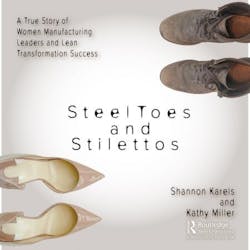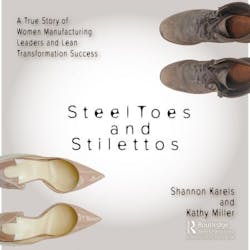Steel Toes and Stilettos: The roles of leadership in effective transformation
In our book we offer the perspectives of each of our roles in the transformation process. So many articles on leadership offer generic tips: be inclusive, take a coach-approach, and be open to feedback, among others. And, while all of those items are certainly true, what is often missing is the textured approach that is needed in different roles of leadership that support the transformation process.
The role of the senior leader accountable for the profit/loss of a business entity, such as a general manager, is responsible for every function in an enterprise. If a senior leader is intent on transforming the manufacturing processes, he or she must be committed to the process and recognize that it is but one of the daily responsibilities that must be attended to. While it is certainly of supreme importance, so are the human-resource issues that arise daily, the financials, the customers and all other stakeholders that demand support and attention. That senior leader must be ready to put in the extra effort that change management demands and be prepared for the inevitable conflict that will arise among members of the team whose lives are being disrupted by a new way of doing their work.
The change agent, on the other hand, has the sole responsibility of making sure the transformation is successful. Before the business benefits are realized, an inordinate amount of work is required to establish the foundation for success. Additionally, it is challenging to convince peer groups and others in the organization that the new way of doing business will contribute to improved performance metrics and work that is less frustrating to them and of more value to the customer. That is especially true when, although anointed with a title, they are of equal status to the others on staff commanding attention and leading their functions with pride and authority.
The senior leader must set the vision for the future of the enterprise and be able to accurately describe what that future looks like to a group of people who, most likely, have not experienced such a future state. That leader must be resolute in the direction the organization is headed and not shy away from communicating the vision repeatedly.
Furthermore, that leader must set the norms for behaviors that will support the transformation. For example, the senior leader needs to place trust in their team to solve problems and offer creative solutions to challenges that can be prolific in a daily manufacturing organization. If an intended solution does not work out according to plan, failure should be treated as a lesson learned, not an event that brings reprisal of any sort.
The change agent must learn that supporting the concerns of the organization is paramount to not only a successful implementation process, but critical to the sustainment of any improvement that is established. Old habits die hard, but with walking beside the people whose work is affected by change, answering their questions, helping them learn how to resolve issues when they arise, a new way of doing business can take hold.This approach requires patience and perseverance on the part of the change agent, whose success is measured by the effectiveness of the transformation; however, when done properly, this will ensure that improvements become part of the foundation to be further built upon.

